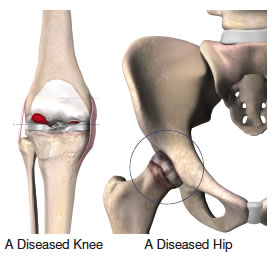Common Causes of Joint Pain
One of the most common causes of joint pain is arthritis. The most common types of arthritis are:
Osteoarthritis (OA)
It is sometimes called degenerative arthritis because it is a “wearing out” condition involving the breakdown of cartilage in the joints. When cartilage wears away, the bones rub against each other, causing pain and stiffness. OA usually occurs in people aged 50 years and older, and frequently in individuals with a family history of osteoarthritis.
Rheumatoid Arthritis (RA)
It produces chemical changes in the synovium that cause it to become thickened and inflamed. In turn, the synovial fluid destroys cartilage. The end result is cartilage loss, pain, and stiffness. RA affects women about 3 times more often than men1, and may affect other organs of the body.
Post-traumatic Arthritis
It may develop after an injury to the joint in which the bone and cartilage do not heal properly. The joint is no longer smooth and these irregularities lead to more wear on the joint surfaces.
Avascular Necrosis
It can result when bone is deprived of its normal blood supply. Without proper nutrition from the blood, the bone’s structure weakens and may collapse and damage the cartilage. The condition often occurs after long-term treatment with cortisone or after organ transplantation.References:
1. Arthritis Foundation website, accessed February 2009.
<< Previous Page || Next Page >>
